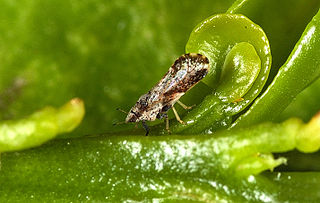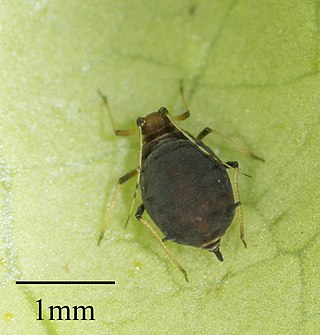
Aphids are small sap-sucking insects and members of the superfamily Aphidoidea. Common names include greenfly and blackfly, although individuals within a species can vary widely in color. The group includes the fluffy white woolly aphids. A typical life cycle involves flightless females giving live birth to female nymphs—who may also be already pregnant, an adaptation scientists call telescoping generations—without the involvement of males. Maturing rapidly, females breed profusely so that the number of these insects multiplies quickly. Winged females may develop later in the season, allowing the insects to colonize new plants. In temperate regions, a phase of sexual reproduction occurs in the autumn, with the insects often overwintering as eggs.

Hemiptera is an order of insects, commonly called true bugs, comprising over 80,000 species within groups such as the cicadas, aphids, planthoppers, leafhoppers, assassin bugs, bed bugs, and shield bugs. They range in size from 1 mm (0.04 in) to around 15 cm (6 in), and share a common arrangement of piercing-sucking mouthparts. The name "true bugs" is often limited to the suborder Heteroptera.

Psyllidae, the jumping plant lice or psyllids, are a family of small plant-feeding insects that tend to be very host-specific, i.e. each plant-louse species only feeds on one plant species (monophagous) or feeds on a few closely related plants (oligophagous). Together with aphids, phylloxerans, scale insects and whiteflies, they form the group called Sternorrhyncha, which is considered to be the most "primitive" group within the true bugs (Hemiptera). They have traditionally been considered a single family, Psyllidae, but recent classifications divide the group into a total of seven families; the present restricted definition still includes more than 70 genera in the Psyllidae. Psyllid fossils have been found from the Early Permian before the flowering plants evolved. The explosive diversification of the flowering plants in the Cretaceous was paralleled by a massive diversification of associated insects, and many of the morphological and metabolic characters that the flowering plants exhibit may have evolved as defenses against herbivorous insects.

The Aphididae are a very large insect family in the aphid superfamily (Aphidoidea), of the order Hemiptera. These insects suck the sap from plant leaves. Several thousand species are placed in this family, many of which are considered plant/crop pests. They are the family of insects containing most plant virus vectors with the green peach aphid being one of the most prevalent and indiscriminate carriers.
Citrus tristeza virus (CTV) is a viral species of the genus Closterovirus that causes the most economically damaging disease to its namesake plant genus, Citrus. The disease has led to the death of millions of Citrus trees all over the world and has rendered millions of others useless for production. Farmers in Brazil and other South American countries gave it the name "tristeza", meaning sadness in Portuguese and Spanish, referring to the devastation produced by the disease in the 1930s. The virus is transmitted most efficiently by the brown citrus aphid.

Diaspididae is the largest family of scale insects with over 2650 described species in around 400 genera. As with all scale insects, the female produces a waxy protective scale beneath which it feeds on its host plant. Diaspidid scales are far more substantial than those of most other families, incorporating the exuviae from the first two nymphal instars and sometimes faecal matter and fragments of the host plant. These can be complex and extremely waterproof structures rather resembling a suit of armor. For this reason these insects are commonly referred to as armored scale insects. As it is so robust and firmly attached to the host plant, the scale often persists long after the insect has died.

Toxoptera citricida is a species of aphid known by the common names brown citrus aphid, black citrus aphid, and oriental citrus aphid. It is a pest of citrus and vector for the pathogenic plant virus citrus tristeza virus. The aphid spread the virus through citrus groves in Brazil and Venezuela in the 1970s, leading to the near destruction of the citrus industry there. This aphid was first discovered in Florida in 1995.

Aphis is a genus of insects in the family Aphididae containing at least 600 species of aphids. It includes many notorious agricultural pests, such as the soybean aphid Aphis glycines. Many species of Aphis, such as A. coreopsidis and A. fabae, are myrmecophiles, forming close associations with ants.

Coccinella transversalis, commonly known as the transverse ladybird or transverse lady beetle is a species of ladybird beetle found from India across southern and southeastern Asia to Malesia and Australia. It is not to be confused with Coccinella transversoguttata, a widespread species in Europe and North America also known as the transverse ladybird. The alternative vernacular of small transverse ladybird may be used for C. transversalis in instances where these two species are discussed together.

Aphis gossypii is a tiny insect, an aphid ("greenfly") in the superfamily Aphidoidea in the order Hemiptera. It is a true bug and sucks sap from plants. It is a widely distributed pest of a variety of agricultural crops in the families Cucurbitaceae, Rutaceae and Malvaceae. Common names include cotton aphid, melon aphid and melon and cotton aphid.

Aleurocanthus woglumi is a species of whitefly in the family Aleyrodidae. It is a pest of citrus crops, and is commonly known as the citrus blackfly because of its slate-blue colour. It originated in Asia, but has spread to other parts of the world. The parasitic wasps, Encarsia perplexa and Amitus hesperidum can help control the pest.

Diaphorina citri, the Asian citrus psyllid, is a sap-sucking, hemipteran bug in the family Psyllidae. It is one of two confirmed vectors of citrus greening disease. It has a wide distribution in southern Asia and has spread to other citrus growing regions.

Zanthoxylum spinosum is a species of flowering plant in the family Rutaceae known by the common name Biscayne prickly-ash. It is native to the West Caribbean, including South Florida and the Florida Keys, Cuba, Bahamas, Cayman Islands, and Hispaniola.

Aphis spiraecola is a species of aphid described in 1914 by Edith Marion Patch. Its common names include green citrus aphid, Spirea aphid, and apple aphid. It is distributed worldwide, and is most abundant in the United States. It has a diploid chromosome number of 2n=8.
The mango aphid is a species of aphid in the superfamily Aphidoidea in the order Hemiptera. It is a true bug and feeds by sucking sap from plants.

Ocyptamus fuscipennis is a species of syrphid fly in the family Syrphidae. This fly can be found throughout North America, as well as in Cuba. In Puerto Rico, this species in its larval stage is an predator of autumn cohorts of Toxoptera citricida. Adult flies are known to visit Xyris tennesseensis flowers.

Toxoptera is a genus of true bugs belonging to the family Aphididae.

Scymnus (Scymnus) nubilus, is a species of lady beetle found in Pakistan, India, Bangladesh, Sri Lanka, Nepal, Myanmar, China, and Asia Minor.















